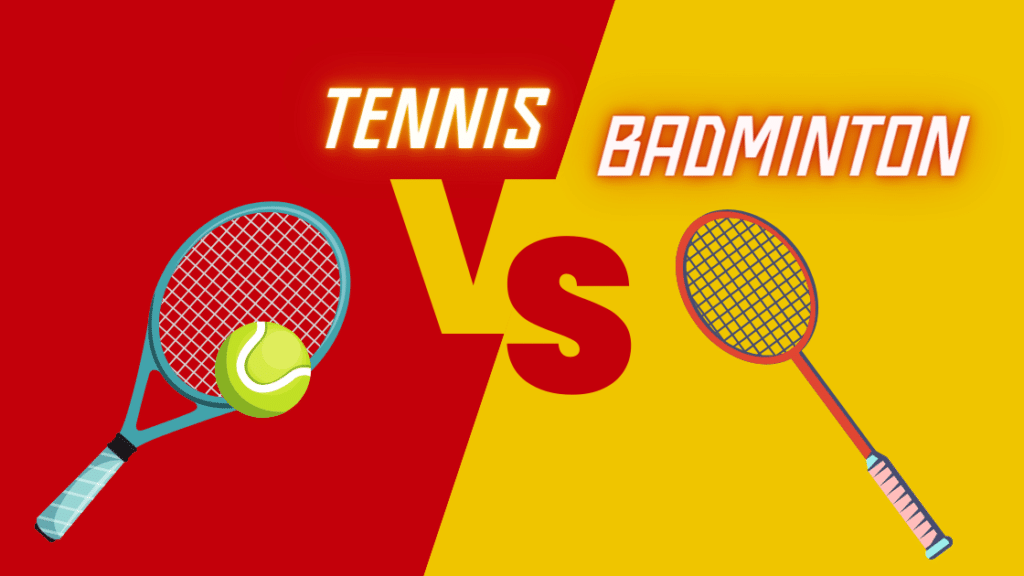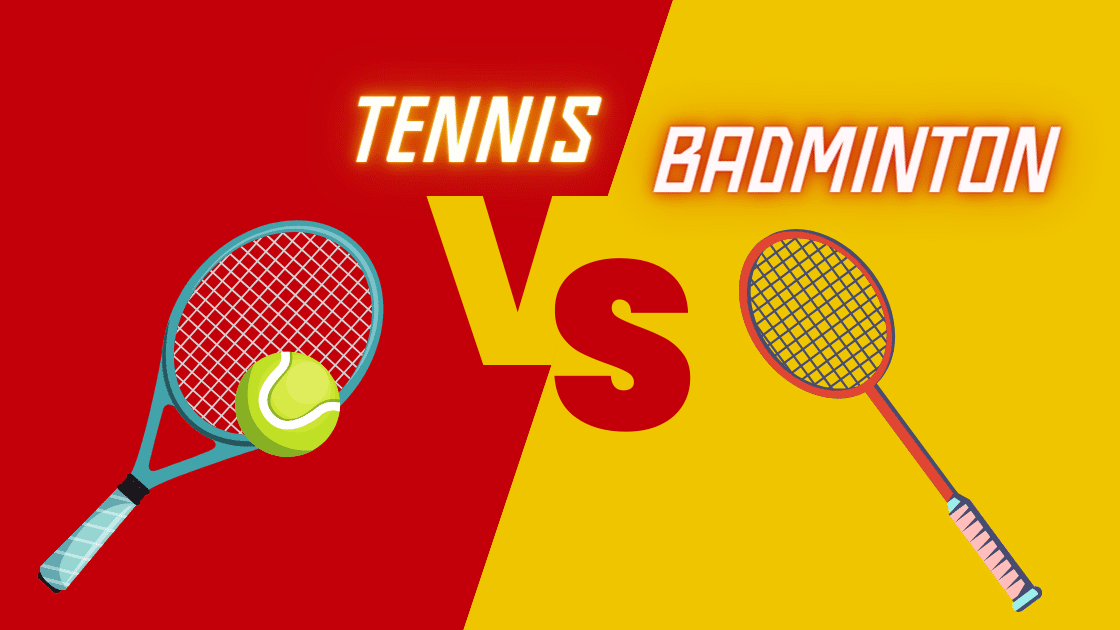Badminton and tennis are two of the most common racket sports. They are often considered to be very similar as the basic idea of hitting an object with a racket over a net is common in both. But these are more different than similar.
How? We will see that in this article. I will point out top similarities and top differences and you can judge how correct is the idea of badminton and tennis being similar.

Badminton vs Tennis
The table below compares badminton vs tennis in detail.
| Aspect | Badminton | Tennis |
| Origins | Originated in India, developed in England. | Originated in France, developed in England. |
| Court | Indoor court For singles, 17 feet x 44 feet For doubles, 20 feet x 44 feet | Outdoor court For singles, 27 feet x 78 feet For doubles, 38 feet x 78 feet |
| Net | 5 feet at the posts and 5.1 feet at the center | 3 feet 6 inches at the post and 3 feet at the center |
| Rackets | Light weight of 80 to 100 grams and flexible | Heavy of 300 to 350 grams and stiffer. |
| Ball/Shuttlecock | Shuttlecock made of goose feathers or synthetic materials | A soft ball with a pressurized rubber core and it is covered in felt. |
| Serve | Underhand | Underhand and Overhand |
| Match Duration | Typically, 40 to 60 minutes. It can be longer. | Varies widely, from 1 hour to over 5 hours. |
| Major Tournaments | All England Open, BWF World Championships, Thomas Cup, Uber Cup, Olympics. | Australian Open, French Open, Wimbledon, US Open, ATP/WTA Finals, Davis Cup, Fed Cup. |
History and Origin
To understand how the two games are different, you must know how they originated and evolved over the years.
Brief History of Badminton
The roots of badminton trace back to the ancient civilizations in Asia. It was first played in India in the 15th century. It was then known as ‘Poona’ or ‘Poonah’ named after the city of Pune in India.
It involved hitting a shuttlecock with paddles across a net. The colonial British officers liked this game and took it with them back home in the mid-1800s. However, the modern version of badminton is named after the Badminton House in Gloucestershire, England.
The first international association called the Badminton Association of England was formed in 1893. It standardized the rules for international competitions.
Brief History of Tennis
Tennis has a European lineage. Its origins can be traced back to 12th-century France. There a game called ‘jeu de paume’ (game of the palm) was played by hitting a ball with the hand across a court.
Over time, rackets were introduced, and the game evolved. This new game gained immense popularity amongst European royalty.
The whole credit for the modern form of tennis goes to Major Walter Clopton Wingfield. He was a British army officer, who in 1874 invented a portable version with a standardized court and rules.
This was known as ‘lawn tennis’ at that time and it spread rapidly across England and eventually across the globe.
Equipment
Let’s start with the equipment required for tennis and badminton.
Rackets
Both sports use a racket but both rackets are very different from each other. The badminton racket is lighter at 80 to 100 grams and the tennis one is heavier at 300 to 350 grams.
The badminton rackets are thinner, so they allow quick movements and rapid shots. Tennis rackets are thicker, so they provide more power and stability.
A major similarity in these rackets is that they are made from materials like carbon fiber, graphite, or graphite composites.
Shuttlecock vs Ball
In badminton, you use a shuttlecock. This shuttlecock is made up of goose feathers attached to a cork base. This is very lightweight around 5 grams, which makes it susceptible to air resistance. It also has a high drag coefficient.
In tennis, you use a softball. It is made of pressurized rubber as the core and covered with felt. It weighs around 50 to 60 grams. This ball can bounce very quickly, so you cannot play effective net shots in tennis.
Courts
The badminton court is smaller than the tennis court. For a singles game, it is 17 feet wide and 44 feet long. For a doubles game, it is 20 feet wide and 44 feet long.
The net is placed exactly in the center of a badminton court. It has a height of 5.1 feet at the center and 5 feet on both sides. This court is placed indoors on wooden or synthetic surfaces.
A tennis court is larger than a badminton court. For a singles game, it is 27 feet wide and 78 feet long. For a doubles game, it is 36 feet wide and 78 feet long.
The net posts are situated 3 feet outside the outermost boundary. The net is placed at a height of 3 feet 6 inches at the posts and 3 feet in the center. This court can be designed outdoors on grass, clay, or even on hard courts.
Gameplay and Rules
Now that equipment is out of the way, let’s focus on the actual play.
Scoring Systems
Badminton uses a point system. It is typically played with the best of 3 games. A player/team has to win 21 points to win a game. If the score reaches 20-20, a player/team must earn 2 more points to win the game. But if the score reaches 29-29, the next point wins the game.
In tennis, the scoring system is based on games. Matches are won based on best of 3 or best of 5 sets. Each set can be won by winning 6 games. Before that, you must know the following notations.
- 0 Points = Love
- 1 Points = 15
- 2 Points = 30
- 3 Points = 40
- 40-40 = Deuce
After reaching 40 points, a player needs to win two consecutive points to win the game. If the score reaches 40-40 (deuce), the player who wins the next point wins the game. However, if the score reaches deuce again, a player needs to win two consecutive points to win the game.
Service Rules
Service in badminton is done underhand. The shuttlecock must be below the level of your waist when the racket hits it. A service is done diagonally to the opponent’s court. You only get one chance to serve. Your score determines which side of the court you will serve from.
In tennis, service can be overhand or underhand. In fact, most players prefer overhand service as it gives more power to the shot. You get two chances to do a serve in tennis. You have to land the ball in the opponent’s field diagonal to you.
Indoor vs outdoor Badminton and Tennis
It might seem obvious but a big difference between the courts for Badminton and those for Tennis is that Badminton has no regulations for outdoor courts because the sport is always played inside.
Tennis originated as an outdoor lawn sport and has been adapted to be played in indoor arenas. Badminton, on the other hand, has never had a outdoor counterpart for courts because the sport becomes impractical when played outside. A shuttlecock weighs 4-6 grams which is nothing compared to a Tennis ball weighin around 60 grams. Playing Badminton outside with a shuttlecock becomes impossible if it’s windy or raining or anything else besides sunshine.
Major Tournaments and Events
Both badminton and tennis have some prestigious international tournaments. Only the best players get to participate in these events.
For badminton, the BWF World Championships are held every two years. It is the ultimate test of skill. Additionally, the All England Open Badminton Championships is an age-old tournament steeped in tradition. The Olympic Games also feature badminton as a medal sport.
For tennis, there are four major tournaments spread across the year – Wimbledon, the US Open, the Australian Open, and the French Open. These are played on different playing surfaces like grass, hard courts, and clay courts.
Iconic Players
The following are some of the famous badminton and tennis players of all time. These players have achieved top rankings and medals in various international tournaments. Their careers are an inspiration for many players all over the world.
| Iconic Badminton Players | Iconic Tennis Players |
| Lin Dan (China) | Roger Federer (Sweden) |
| Lee Chong Wei (Malaysia) | Rafael Nadal (Spain) |
| Tai Tzu-Ying (Taiwan) | Novak Djokovic (Serbia) |
| Carolina Marin (Spain) | Serena Williams (United States) |
| Saina Nehwal (India) | Steffi Graf (Germany) |
Conclusion
Both tennis and badminton are excellent sports. They require the same level of physical training, and both can be played by people of all ages. If you need to choose between the two, you can try both games and select the one that you like the most.
It is not recommended to play both games because the techniques used are different for each. There’s a possibility that you will get confused. So, it’s better to stick to one game.
FAQs
Can I play badminton on a tennis court?
You can play badminton on a tennis court, but you will need to redraw the lines on the court to accommodate standard badminton court size requirements.
Are badminton and tennis court surfaces the same?
No, badminton and tennis court surfaces are not the same. Badminton courts are usually soft mats laid on wood or asphalt. Tennis courts could be made of hard surface, grass, or clay.
Which is tough – badminton or tennis?
Badminton is tougher to play than tennis because it requires agility, precision, strength, and more. You also have to play in a small area as compared to tennis.
Can we play badminton with tennis rackets?
No, Tennis rackets are not designed to play badminton. Badminton rackets have a lighter head and a larger size to hit shuttlecocks. Tennis rackets weigh more and are designed for hitting balls. It would be difficult to play properly if you used a tennis racket.
Is badminton harder than tennis?
Badminton, with its fast-moving shuttlecocks, is considered to be harder than tennis. Tennis requires more endurance and strength because of its larger court size and longer rallies.
